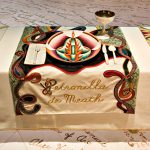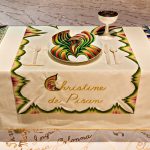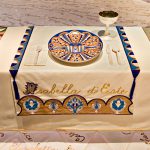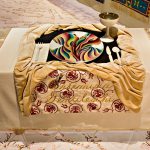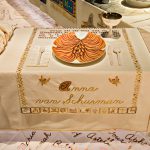This is part 2 of the series on The Dinner Party By Judy Chicago. I will be splitting this into 2 parts as it gets a bit long I noticed with the first one. Please enjoy!
I do shorten what is on the website to make it slightly more readable in our format here.
The photos and all information in this post are from the Brooklyn Museum. (Copyright © 2004–2019 the Brooklyn Museum.)
Link to Website: https://www.brooklynmuseum.org/eascfa/dinner_party/home

Wing One blog here.
Wing Two – Part One here.
Wing Two
Christianity to the Reformation

- Judy Chicago (American, b. 1939). The Dinner Party (Petronilla de Meath place setting), 1974–79. Mixed media: ceramic, porcelain, textile. Brooklyn Museum, Gift of the Elizabeth A. Sackler Foundation, 2002.10. © Judy Chicago. Photograph by Jook Leung Photography
- Judy Chicago (American, b. 1939). The Dinner Party (Petronilla de Meath plate), 1974–79. Porcelain with overglaze enamel (China paint) and paint, 13 3/4 × 14 × 1 in. (34.9 × 35.6 × 2.5 cm). Brooklyn Museum, Gift of the Elizabeth A. Sackler Foundation, 2002.10. © Judy Chicago. (Photo: © Donald Woodman)
(b. circa 1300, Meath, Ireland; d.1324, Kilkenny, Ireland)Petronilla de Meath was the first Irish woman to be burned at the stake for the crime of heresy. She served as a maid to Lady Alice Kyteler, one of the earliest women to be accused of witchcraft.
In Kilkenny, Ireland in 1324, Lady Alice Kyteler, along with her son and ten others, became one of the earliest targets of witchcraft accusations, centuries before the more famous rash of witch trials in the sixteenth and seventeenth centuries. She was charged by the Bishop of Ossory with a wide slate of crimes, from sorcery and demonism to the murders of several husbands. Lady Alice was believed to have illegally acquired her wealth through magical and devilish means.
To extract her confession, the bishop ordered the torture of Lady Alice’s maid and confidante, Petronilla de Meath. Petronilla claimed that she and her mistress applied a magical ointment to a wooden beam, which enabled both women to fly. She was then forced to proclaim publicly that Lady Alice and her followers were guilty of witchcraft.
With the help of relatives, Lady Alice used her connections to flee to England, taking with her Petronilla’s daughter, Basilia. Lady Alice’s followers, including Petronilla, remained behind. Some were convicted and whipped, but others, Petronilla included, were burned alive at the stake. This was not the first recorded sentence of death by burning for heresy, but was the first known trial to treat women practicing witchcraft as an organized group. Petronilla serves as an emblem of the many women tried and convicted of witchcraft during the Middle Ages.
Petronilla de Meath at The Dinner Party
Petronilla’s place setting employs many of the most familiar symbols of witchcraft from both Petronilla’s time and today, including the broomstick incorporated into the illuminated letter “P” on the front of her runner.
The interlacing patterns on the front and top of the runner are based on Celtic motifs drawn from The Book of Kells, a book of illuminated manuscripts dating to the 9th century. On the back of the runner there is a horned form, representing the goat that was worshipped by many covens, or groups of witches. The red cords lining the black front edge echo the red witch’s garter, which signified higher rank in the coven.
The plate also incorporates other symbols of witchcraft, including a bell, a book, and a candle. The cauldron represents both the Great Mother, to whom witches pay honor, and the meeting place of covens. The flames that “envelop the center of the plate are a terrible inversion of the sacred fire that once burned in honor of the Goddess…” (Chicago, A Symbol of Our Heritage, 78).
- Judy Chicago (American, b. 1939). The Dinner Party (Christine de Pisan place setting), 1974–79. Mixed media: ceramic, porcelain, textile. Brooklyn Museum, Gift of the Elizabeth A. Sackler Foundation, 2002.10. © Judy Chicago. Photograph by Jook Leung Photography
- Judy Chicago (American, b. 1939). The Dinner Party (Christine de Pisan plate), 1974–79. Porcelain with overglaze enamel (China paint), 14 × 14 × 1 3/16 in. (35.6 × 35.6 × 3 cm). Brooklyn Museum, Gift of the Elizabeth A. Sackler Foundation, 2002.10. © Judy Chicago. (Photo: © Donald Woodman)
(b. 1364, Venice, Italy; d. 1430, Poissy, France)Christine de Pisan (Christine de Pizan) was a medieval writer and historiographer who advocated for women’s equality. Her works, considered to be some of the earliest feminist writings, include poetry, novels, biography, and autobiography, as well as literary, political, and religious commentary. De Pisan became the first woman in France, and possibly Europe, to earn a living solely by writing.
De Pisan was raised at court in Paris with her father, Thomas de Pisan, the astrologer and secretary to King Charles V of France. In 1380, de Pisan married Etienne du Castel, a nobleman from Picardy. He was an unusual husband for the time in that he supported her educational and writing endeavors. When he died in 1390, de Pisan was only in her early twenties. After receiving attention from patrons in the court for her poetry and love ballads dedicated to her husband, she decided that rather than remarry she would support her three children and newly widowed mother through her writing. While she was still establishing herself as a writer, de Pisan also transcribed and illustrated other authors’ works.
Her own writing, in its various forms, discusses many feminist topics, including the source of women’s oppression, the lack of education for women, different societal behaviors, combating a misogynistic society, women’s rights and accomplishments, and visions of a more equal world. De Pisan’s work, though critical of the prevailing patriarchy, was well received, as it was also based in Christian virtue and morality.
Le Dit de la Rose (The Tale of the Rose), 1402, was a direct attack on Jean de Meun’s extremely popular Romance of the Rose, a work about courtly love that characterized women as seducers, which de Pisan claimed was misogynistic, vulgar, immoral, and slanderous to women. She later published Letters on the Debate of the Rose as a follow-up to the controversial debate.
Although de Pisan’s work was primarily written for and about the upper classes (the majority of lower class women were illiterate), her writing was instrumental in introducing the concept of equality and justice for women in medieval France. De Pisan lived the majority of her life in relative comfort, and in 1418, she entered a convent in Poissy (northwest of Paris), where she continued to produce work, including her last poem Le Ditie de Jeanne d’Arc (Song in Honor of Joan of Arc), 1429.
Christine de Pisan at The Dinner Party
Christine de Pisan is represented in her plate as an abstracted butterfly form painted in swirling, vibrant hues of red and green. Chicago describes the form as having “one wing raised in a gesture of defense, to symbolize her efforts to protect women” (Chicago, The Dinner Party, 86).
The runner is done in tones from the same color palette, and jagged flame-like forms adorn the edges. The wavy, colorful pattern is characteristic of Bargello needlepoint, also called “flame stitch” or “Florentine stitch,” thought to have originated in medieval Italy. According to Chicago, this design, which appears to be encroaching on the plate, represents the suffocating Renaissance-era constraints on women (Chicago, The Dinner Party, 86).
On the front of the runner, embroidered on the illuminated capital “C” in her name, is a scene based on an illuminated manuscript in which de Pisan presents a volume of her work to the queen of France.
- Judy Chicago (American, b. 1939). The Dinner Party (Isabella d’Este place setting), 1974–79. Mixed media: ceramic, porcelain, textile. Brooklyn Museum, Gift of the Elizabeth A. Sackler Foundation, 2002.10. © Judy Chicago. Photograph by Jook Leung Photography
- Judy Chicago (American, b. 1939). The Dinner Party (Isabella d’Este plate), 1974–79. Porcelain with overglaze enamel (China paint), yellow luster, and rainbow overglaze, 13 7/8 × 13 7/8 × 1 3/16 in. (35.2 × 35.2 × 3 cm). Brooklyn Museum, Gift of the Elizabeth A. Sackler Foundation, 2002.10. © Judy Chicago. (Photo: © Donald Woodman)
(b. 1474, Ferrara, Italy; d.1539, Romagna, Italy)Isabella d’Este (Gonzaga) was a powerful and well-educated political figure, humanitarian, patron of the arts, and mother of seven. Known as “The First Lady of the Renaissance,” she was related to nearly every ruler in Italy either by birth or marriage.
D’Este was the oldest of six children born into the ruling family in Ferrara, Italy. Her parents believed in schooling their daughters equally to their sons, and she received an education not frequently afforded women. At sixteen, she could speak and translate Greek and Latin and had a variety of musical talents, including singing, dancing, and playing the lute. She could also engage in intellectual debates with ambassadors.
In 1490, d’Este married Francesco Gonzaga, the fourth marquis of Mantua, and thus became the marchioness. When he was captured as a prisoner of war in 1509, d’Este became the acting regent of Mantua. She secured the loyalty of her people and was able to successfully control the military, eventually negotiating the release of the ailing Gonzaga. D’Este was known for a non-confrontational approach to foreign policy. She kept the support of her people by defending Mantua against French attacks in 1527 and offering aid and comfort to refugees. Gonzaga was often jealous of d’Este’s popularity, and due to this conflict, d’Este traveled to Rome to spend time in the court of Pope Leo X, where she met and became a patron of many artists.
In 1519, Gonzaga died and their son Federigo II officially became marquis of Mantua. At age nineteen he was too young to rule, and d’Este acted as regent. Soon after he took power, he was persuaded by popular support to request that his mother return as head of Mantua. With her authority, she positioned Mantua as a duchy, or sovereign territory, which advanced her son’s title to that of duke.
D’Este was a great patron of the arts, supporting painters such as Mantegna, Titian, and da Vinci, all of whom she commissioned to paint her portrait. She transformed Mantua into a cultural center by converting the ducal apartments into a museum. She invited writers, artists, and poets to her home to exchange ideas and corresponded frequently with a variety of prominent figures, letters that now provide us with a rare woman’s point of view on Renaissance Italy. During her time as ruler, d’Este also funded an ongoing school for girls.
In 1529, as the result of an exchange of property during her husband’s life, d’Este became the official ruler of Solarolo, a small region of Romagna that she ruled as a city-state. There, she oversaw an active government until her death in 1539.
Isabella d’Este at The Dinner Party
The plate, painted in gold, white, and royal blue, is characteristic in its color palette and motifs of the popular Urbino majolica ceramicware, created in factories that d’Este supported. The gold sections of the plate are raised, providing the structural framework for the design. The plate highlights Renaissance artistic innovations, including the use of perspective, horizon lines, and vanishing points. These techniques, popular in antiquity, were revived in the Renaissance and were used to create three-dimensional and realistic works. These artistic ideals are represented by the colonnade in the center of the plate, which has a vanishing point that makes it appear to recede into space.
The runner is designed like a royal banner, complete with tassels, shields, and fleur-de-lys, patterns reserved for the ruling classes. The insignia on the back of the runner was derived from the d’Este crest. The tassels reference the similarly ornamented gowns shown in many Renaissance portraits.
- Judy Chicago (American, b. 1939). The Dinner Party (Elizabeth R. place setting), 1974–79. Mixed media: ceramic, porcelain, textile. Brooklyn Museum, Gift of the Elizabeth A. Sackler Foundation, 2002.10. © Judy Chicago. Photograph by Jook Leung Photography
- Judy Chicago (American, b. 1939). The Dinner Party (Elizabeth R. plate), 1974–79. Porcelain with overglaze enamel (China paint), rainbow luster glaze, silk chiffon covered plastic ring, linen, dyed lace, gold wrapped cord, thread, and pearls, 14 × 14 × 1 in. (35.6 × 35.6 × 2.5 cm). Brooklyn Museum, Gift of the Elizabeth A. Sackler Foundation, 2002.10. © Judy Chicago. (Photo: © Donald Woodman)
(b. 1533, London, England; d. 1603, London, England)Queen Elizabeth I, or Elizabeth R, as she referred to herself, was a revered English queen, and a member of the Tudor family, who ruled over a period of English history often referred to as “The Golden Age.” Ascending the throne at a time when England was in religious conflict and economic hardship, Elizabeth earned her country’s respect as a bold and independently minded ruler, who successfully lifted England out of its troubled state.
As queen, Elizabeth quickly set out a plan to stabilize England following years of conflict under turbulent and controversial rulers. Religion quickly became one of the new queen’s primary concerns. Years earlier, King Henry had severed England’s ties with the Catholic Church so that he could obtain a divorce. Following, Mary I, a Catholic, also known as “Bloody Mary,” re-established Catholicism as the state religion and during her reign, persecuted many Protestants. The English public welcomed Elizabeth’s ascension to the throne, and she reinstated Protestantism in 1559. She is heralded as a champion of religious freedom and tolerance, although there is evidence that she persecuted Catholics in an effort to establish a Protestant state.
During Elizabeth’s rule, the British Empire prospered politically and economically, expanding westward as the first British colonists arrived in America in the mid sixteenth century. In 1588, England finally defeated the Spanish Armada, ending a decades-long threat from Spain, a country attempting to retain its dominance as a world power. The victory increased her popularity with her people and caused economic growth during the relative period of peace.
The literary, performing, and fine arts flourished during Elizabeth’s reign as well, with countless artists, such as Nicholas Hilliard, and playwrights, such as William Shakespeare, benefiting from the court’s patronage.
Although revered by her people and courted by suitors, Elizabeth never married. Despite her father’s lifelong reservations about a woman occupying the throne, Elizabeth’s arrival ushered in a new era in British royal history. She quickly and consistently proved herself to be a powerful and intelligent ruler and an inimitable symbol of female strength. Her nearly half-century reign ended officially with her death in 1603.
Elizabeth R. at The Dinner Party
An expert in determining her own representation in art, Elizabeth often commissioned artists to paint portraits of her in sumptuous costumes. Those same portraits, created while Elizabeth was at the height of her reign, inspired her place setting. The Queen’s elaborate dresses are suggested in the undulating folds depicted on the plate, and the regal deep blues, purples, and reds are reminiscent of the colors typically used in her portraits. The plate is adorned with an embroidered fabric ruff, the lace edges reminiscent of the high, stiff collars Elizabeth wore. A “cloth of gold” placed over the ruff recalls the famous “Field of the Cloth of Gold,” an event in which Elizabeth’s father met with Francis I of France and Charles V, the Holy Roman Emperor, to negotiate a treaty. For the three weeks of the meeting, the monarchs had ostentatious tents made of gold cloth set up in a field.
The runner includes feather and floral patterns stitched in blackwork, a form of textile decoration in which outlines of flowers and leaves are interspersed with geometric patterns. This intricate embroidery was popular on costumes during Elizabeth’s reign and can be seen in portraits of the queen.
Elizabeth’s royal signature is the basis for the illuminated capital letters “E” and “R” in her name on the front of her runner, referring to Elizabeth as she referred to herself, “Elizabeth R.” The elaborate and snaking “R” was used by the Queen after her name; it stood for “Regina,” which is Latin for queen. Elizabeth’s name is embroidered in her own inimitable penmanship. Just as she refused to give up any self-control during her lifetime, Elizabeth personally introduces herself to The Dinner Party guests in her own exquisite hand.
- Judy Chicago (American, b. 1939). The Dinner Party (Artemisia Gentileschi place setting), 1974–79. Mixed media: ceramic, porcelain, textile. Brooklyn Museum, Gift of the Elizabeth A. Sackler Foundation, 2002.10. © Judy Chicago. Photograph by Jook Leung Photography
- Judy Chicago (American, b. 1939). The Dinner Party (Artemisia Gentileschi plate), 1974–79. Porcelain with overglaze enamel (China paint), 14 × 14 × 1 in. (35.6 × 35.6 × 2.5 cm). Brooklyn Museum, Gift of the Elizabeth A. Sackler Foundation, 2002.10. © Judy Chicago. (Photo: © Donald Woodman)
(b. 1593, Rome Italy; d.1652/3, Naples, Italy)Our blog about her here. 🙂
Artemisia Gentileschi was an early Italian Baroque painter, and the only female follower of Caravaggio, whom she worked with in Italy in the early 17th century. Her innovative compositions and focus on Biblical heroines set her apart from her male contemporaries and have lead to the celebration of Gentileschi as a painter with a uniquely female perspective.
Gentileschi was born in Rome, the daughter of celebrated painter Orazio Gentileschi. As a young girl, she served as an apprentice to her father, learning the skills of a professional painter. When her father recognized that she had advanced beyond his training, he hired the painter Agostino Tassi to further her painting skills. In 1612, Tassi raped Gentileschi, an event now inextricably linked to her name. After a lengthy and painful trial, Tassi was found guilty and jailed for eight months. This event had a tremendously negative impact on Artemisia Gentileschi’s reputation, and the artist suffered from gossip that branded her a promiscuous woman.
Soon after the trial, Orazio Gentileschi arranged a marriage for his daughter, after which she moved to Florence, Italy, where she earned the generous support and patronage of the Medici duke, Cosimo II. In 1616, she was the first woman to be accepted into the Florentine Academy of Fine Arts, where she continued her artistic education. During this period, Gentileschi was held in high esteem by both the royal court and scholars, eventually establishing a much-heralded relationship with the astronomer, philosopher, and physicist, Galileo.
She and her husband had two daughters, both of whom eventually became painters. When Gentileschi and her husband separated, she became the head of her own household, enjoying a freedom and independence known to few of her female contemporaries. She and her daughters frequently moved in Italy for career opportunities and to accommodate patronage that included the Medici family and King Charles I of England. In 1641, Gentileschi relocated to Naples where she lived out the remainder of her life. While Gentileschi was a recognized painter in her lifetime, after her death a great deal of her work fell into obscurity and was often attributed to other followers of Caravaggio or to her father.
Art historian Mary Garrard notes that Artemisia Gentileschi “suffered a scholarly neglect that is unthinkable for an artist of her caliber” (Garrard, Artemisia Gentileschi, 3). Only now, in light of recent academic activity, has Gentileschi become recognized for her retelling of biblical stories from the perspective of a woman.
Artemisia Gentileschi at The Dinner Party
Judy Chicago celebrates the link between Artemisia Gentileschi and her often-painted subject, Judith, by repeating the place setting’s color palette. Additionally, the sword image that pierces the first letter “A” of “Artemisia” is the same as that of the “J” in Judith’s illuminated letter, signifying each woman’s physical and emotional strength. The illuminated letter “A” on Gentileschi’s runner is comprised of an artist’s paintbrush and palette, representing her life as an artist.
The plate is surrounded by rich and luscious velvet fabric, modeled on the costumes of Gentileschi’s female subjects. The gold fabric references the color in Gentileschi’s paintings, which became known as “Artemisia gold,” and was often associated with the artist. Chicago explains that this fabric nearly engulfs the plate, representing the safe, protective environment that Orazio Gentileschi attempted to create for his daughter (Chicago, A Symbol of Our Heritage, 82). Underneath the velvet there is fabric decorated in a repeating Baroque-style pomegranate motif, indicative of the time period in which Gentileschi painted. This stenciled motif was modeled on “bizarre silk,” a popular style in the seventeenth century in which pattern was overlaid on pattern, creating a repetitive and unique design.
The butterfly image of Gentileschi’s plate demonstrates the chiaroscuro technique, made famous by one of the artist’s masters, Caravaggio. Chiaroscuro uses a dramatic play of light and dark to convey a theatrical quality to the painting and was popularized during the Baroque period. The “twisting and turning form” on the plate serves also to represent the “extraordinary efforts required of any women of [Gentileschi’s] time who desired to become an artist” (Chicago, The Dinner Party, 97).
- Judy Chicago (American, b. 1939). The Dinner Party (Anna van Schurman plate), 1974–79. Porcelain with overglaze enamel (China paint), metallic yellow luster glaze, and iridescent luster glaze, 15 × 14 × 13/16 in. (38.1 × 35.6 × 3 cm). Brooklyn Museum, Gift of the Elizabeth A. Sackler Foundation, 2002.10. © Judy Chicago
(b. 1607, Cologne, Germany; d. 1678, Wieuwerd, Netherlands)Anna Maria van Schurman is readily considered the most highly educated woman of the 17th century. She questioned the role that women should play in Dutch society, and her determination to receive an education, along with her achievements, made her stand out from other women of her time. Her radical belief that women should be educated to receive an education, not just for a professional purpose or for employment, was controversial and differed from other 17th century arguments for the education of women.
Van Schurman received a strong classical education from her father. Considered a child prodigy, she could freely read and translate both Latin and Greek by the age of seven and had learned German, French, Hebrew, English, Spanish, and Italian by age eleven. She also studied art and became a distinguished artist in the fields of drawing, painting, and etching, though few examples of her art exist today.
At the age of 29, after years of advocating for women’s education, van Schurman was invited to attend the University of Utrecht as the first female student. The administration required that she sit behind a curtain in class, as they believed she would distract the male students. She graduated with a degree in law—the first female graduate.
Van Schurman spent much of her adult life writing on the importance of equal education for women, publishing the majority of her works in the 1640s and 50s. In her book Whether the Study of Letters is Fitting for a Christian Woman, published in 1646, she stated that anyone with ability and principles should be allowed to be educated. She believed women should receive an education in all subjects, so long as it did not interfere with their domestic duties.
She actively published articles detailing the ways in which women’s brains functioned as effectively as men’s, and the damage that occurred to women’s abilities if they were only considered capable of being wives and mothers.
Anna van Schurman at The Dinner Party
Anna Maria van Schurman’s plate is painted with many thin lines, referencing popular Dutch etchings of the 17th century. Chicago chose an abstracted butterfly form for the plate, a symbol of “Anna’s valiant efforts on behalf of women’s rights” (Chicago, The Dinner Party, 100).
The colors of the plate, shades of orange, complement the colors of the runner, which is embroidered in a style that was common in 17th century Holland. Young girls practiced these tiny stitches on samplers, which were meant to teach them the virtues of womanhood, such as docility and obedience. The needlework represents the educational limits of van Schurman’s Dutch counterparts (Chicago, Embroidering Our Heritage, 176) and shows how girls were forced to “think small” during this period (Chicago, The Dinner Party, 83).
The runner is patterned on early stitch samplers; on the back is an embroidered flower basket, a common motif in Dutch samplers that signified renewal. The rabbit, also a sampler motif, represented timidity. These images of domesticity are offset by the embroidered angels flanking van Schurman’s name, which reflect her role as a religious leader.
Van Schurman, in her writings and her life, fought the idea that women should be confined to domesticity. One of her famous quotes is embroidered across the top of the runner:
Woman has the same erect countenance as man, the same ideals, the same love of beauty, honor and truth, the same wish for self-development, and yet she is to be imprisoned in an empty soul of which the very windows are shuttered.
